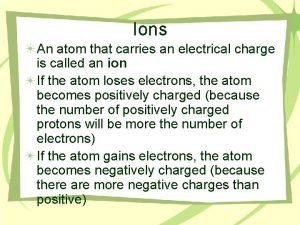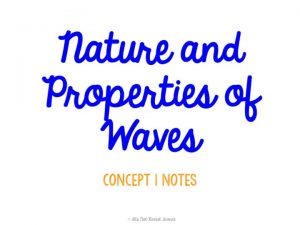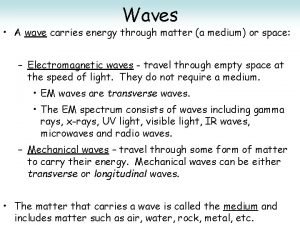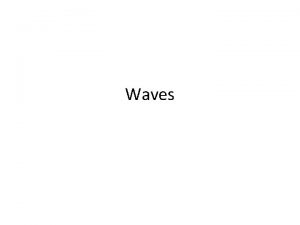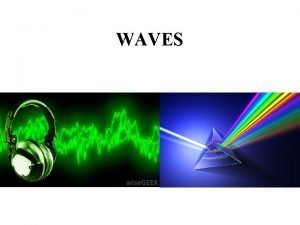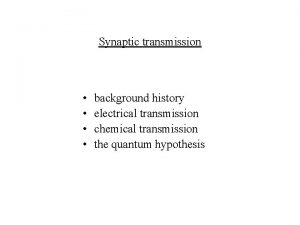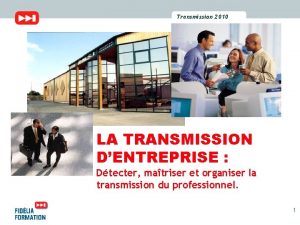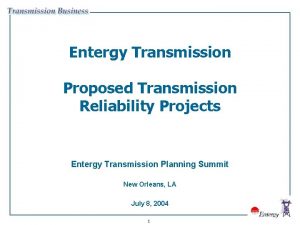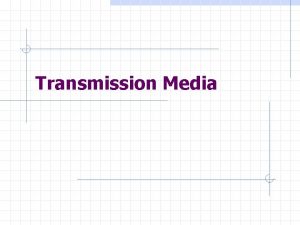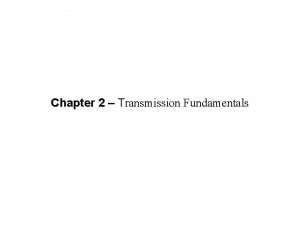Transmission of Electrical Energy Electrical energy is carries








- Slides: 8

Transmission of Electrical Energy Electrical energy is carries by conductors such as overhead transmission lines and underground cables. The conductors are usually aluminum cable steel reinforced (ACSR), with steel core and aluminum conductors wrapped around the core. In addition to phase conductors, a transmission line include one or two steel wires known as ground or shield wires. Cable lines are designed to be placed underground or under the water. In cables, the conductors are insulated from each other and surrounded by a protective sheath. They are more expensive than overhead power lines. Transmission lines are characterized by a series resistance and conductance per unit length, and by a shunt capacitance per unit length. 1

Models: Two-wire Conductor and a Coaxial Cable R and L Jacket Braid C Shield Dielectric Conductor 2

Transmission Line Limits • The maximum steady-state line current must be limited to prevent overheating in the transmission line. The power loss in a transmission line is approximately given by: • The voltage drop in a practical transmission line should be limited to about 5%. • The angle in a transmission line should be less than 30 o. This limitation ensures the power flow in a transmission line is well below the static stability limit, ensuring that the power system can handle transients in a stable manner. 3

Generation, Transmission, and Distribution GENERATION TRANSMISSION Interconnection Substation G 1 Generators Transmission Substation Distribution Substation 2. 4 k. V 115 k. V 345 k. V to G 2 DISTRIBUTION 1 -phase 120/240 V 230 k. V 3 -phase 69 k. V 765 k. V Heavy industry Medium industry Small-scale industry and residences 4

Types of Power Lines • Low-Voltage (LV) Lines: Provide power to building, factories, and houses. The lines may be overhead or underground operating at 600 V or less. • High-Voltage (HV) Lines: The voltage is usually between 2. 4 k. V and 69 k. V. Such systems are preferred in large cities. The transmission lines spread out like fingers from one or more substation to various loads such as campuses, shopping centers, etc. • Extra-High-Voltage (EHV) Lines: They connect the main substations to the generating plants. Such lines operate at voltages up to 800 k. V and may be as long as 1000 km. 5

Lightning Strokes Charge separation takes place inside clouds, so that positive charges move to the upper part of the cloud while negative charges stay below. The transfer of electric charges sets up an electric field within the cloud. Also the negative charges at the base of the clouds repels the free electrons on the ground below and accordingly the ground becomes positively charged. ++++++ _____ ++++ 6

Lightning and Transmission Lines • When lightning makes a direct hit on a transmission line, it deposits a large electric charge, producing an enormous over voltage between the line and ground. The dielectric strength of air is exceeded and the flashover occurs. The line discharge itself and the over voltage disappears in less than 50 microsecond. Adequate protection against lightning requires good grounding. 20 k. A 69 k. V neutral BIL Insulating Material Solid Electrical Ground (20 ohm) 7 BIL: Basic Impulse Insulation

Example: A 3 -phase 69 k. V transmission line having a BIL of 300 k. V is supported on steel towers and protected by a circuit breaker. The ground resistance at each tower is 20 ohm. The neutral of the transmission line is also grounded at the transformer just ahead of the circuit breaker. During an electric storm, one of the towers is hit by a lightning stroke of 20 k. A. Find the voltage across each insulator. 8
 Isotope charge
Isotope charge Is a disturbance that transfers energy from place to place
Is a disturbance that transfers energy from place to place Frequency and wavelength relation
Frequency and wavelength relation Wave medium
Wave medium Describe the rhythmic movement of a wave
Describe the rhythmic movement of a wave Wave disturbance
Wave disturbance Rhythmic disturbance that carries energy
Rhythmic disturbance that carries energy These are rhythmic disturbances that carry energy
These are rhythmic disturbances that carry energy Waves that use matter to transfer energy
Waves that use matter to transfer energy
